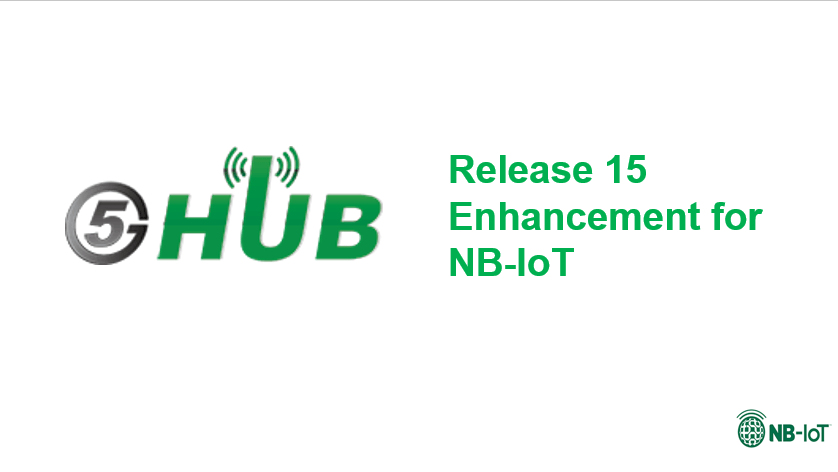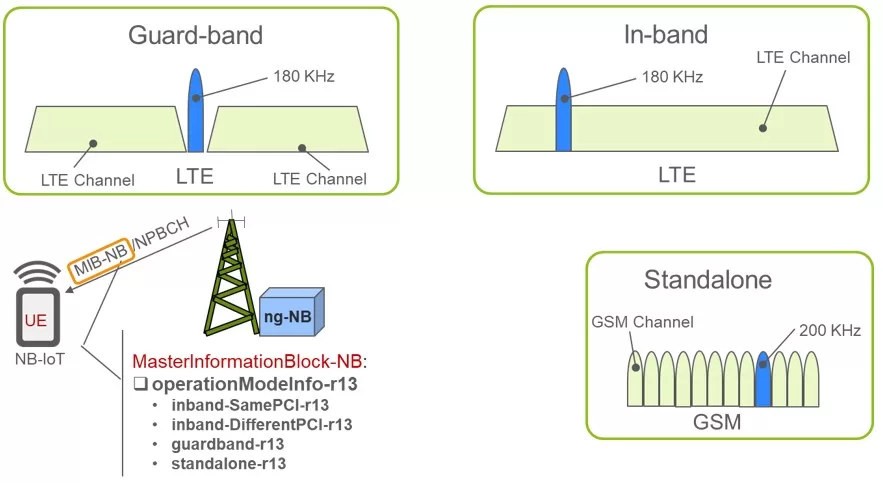Introduction
Narrowband IoT (NB-IoT) is a 3GPP radio technology standard that addresses the requirements of the Internet of Things (IoT). The technology provides improved indoor coverage, support of a massive number of low throughput devices, low delay sensitivity, ultra-low device cost, low device power consumption, and optimized network architecture.
Examples include smart meters, networked trash cans, bicycles, apiaries, and mousetraps. Initial network deployment began in late 2017, and global commercial deployment began in 2018. NB-IoT can be deployed in LTE carriers, in LTE guardbands, and as a standalone solution.
Now, the extremely flexible numerology of 5G NR makes it easier for NB-IoT to operate in the 5G band.
NB-IoT Feature Deployment
NB-IoT has different features (Basic and optional) starting from Release 13, Release 14 reaching to Release 15. The below table from GSMA summarized the different features from the three releases.
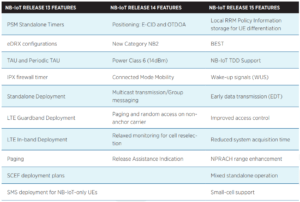
NB-IoT Features
In release 13, the most two important features are Power Saving Mode (PSM) and Extended Discontinuous Reception (eDRX), the two below features are designed to help IoT devices conserve battery power and potentially achieve a 10-year battery life.
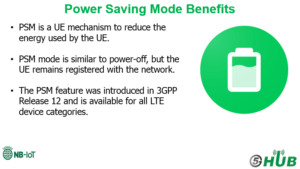
Power Saving Mode Benefits
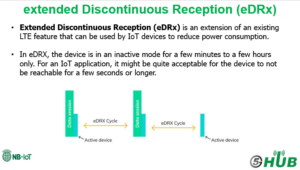
eDRX
NB-IoT Release 15 Enhancement features
Release 15 standards are built upon Rel-13 and 14 features (for example, low-complexity UE categories M1 and M2, and CE Modes A and B) by adding support for new use cases and enhancements for further improvements with respect to latency, power consumption, spectral efficiency, access control, and mobility as well as narrowband Reference Signal Received Power (RSRP) measurement accuracy.
Here we’ll discuss the most important NB-IoT release 15 features, that most probably will be optional.
- Wake-up signals (WUS)
When a UE is in DRX or eDRX, it has to regularly check if a paging message is arriving from the core network. At most possible occasions for paging, no message arrives for the UE and the power the UE consumed could have been saved.
This feature allows the eNB to send the UE a ‘wake-up signal’ (WUS) to instruct the UE that it has to monitor NPDCCH for paging, and otherwise allows the UE to skip the paging procedures. This allows the UE to potentially keep parts of its hardware switched off for more of the time, and save the power of decoding NPDCCH and NPDSCH for paging.
Depending on how long the network allows for the UE to ‘wake up’ after receiving a WUS, the UE may be able to keep switched on only a receiver dedicated to WUS detection, allowing much of the UE’s conventional hardware to remain in a very low-power state. - NPRACH range enhancement (FDD)
NB-IoT is sometimes deployed in cells with a radius of up to around 100 km. Rel-13 NPRACH supports cell radius up to 40 km with an unambiguous determination of the UE range. Beyond that distance, because NPRACH is a pure sine wave transmission, there can be ambiguities for the eNB to determine the UE’s range.
A new NPRACH format is introduced with a subcarrier spacing of 1.25 kHz and a cyclic prefix of 800 μs, together with frequency hopping, which is sufficient to allow unambiguous range determination up to 120 km. - Scheduling request (SR)
In Release 13/14 NB-IoT, a scheduling request (SR) exists only as a higher-layer procedure, which triggers a random access procedure to request sufficient UL resource to send a buffer status report (BSR). Release 15 has added new, more resource and power-efficient, ways to achieve this goal which can be configured by the eNB.
For a connected mode UE, eNB is able to configure by RRC periodic NPUSCH resources for the UE to send BSR, so the eNB is informed when pending traffic has arrived in the UE’s Page 33 of 43 buffer. The resources are activated and de-activated (‘released’) by dynamic signaling on NPDCCH.
A connected mode UE is able to send, in the physical layer, a request to the eNB to be granted NPUSCH resources to send a BSR. This can be done either by a dedicated signal using a pre-configured NPRACH transmission or via ‘piggybacking’ the request onto HARQ ACK or NACK transmission from the UE if one is available, by applying a cover code to the ACK or NACK symbols. - Reduced system acquisition time (FDD)
In FDD, when SIB1-NB is being transmitted with 16 repetitions (the maximum supported), eNB can transmit additional subframes containing SIB1-NB repetitions on anchor carriers and non-anchor carriers to allow faster decoding of SIB1- NB and reduce the UE’s power consumption during cell access. Compared to Rel-13 which supports up to 8 SIB1-NB repetitions, Rel-15 allows 16 repetitions. - BEST (Battery Efficiency Security for low Throughput)
Network-based end to middle or end to end (depends on the customer requirement) security solution for payload encryption with very low overhead which is an important requirement for battery-driven devices. This solution can be used on the control plane and use the symmetrical cryptography based on the 3GPP AKA run. The solution needs to be implemented on the core (HSE) and device side (chipset/module).
The operators have full control of the tunnel establishment and payload encryption (for the countries that payload encryption is not allowed by the government).
References:
- 3GPP TR 21.915 version 15.0.0 Release 15.
- ITU, “Traffic engineering and advanced wireless network planning” 17-19 October 2018, Suva, Fiji.
- GSMA, NB-IoT Deployment Guide.
- Ericsson, A Primer on 3GPP Narrowband Internet of Things (NB-IoT).

